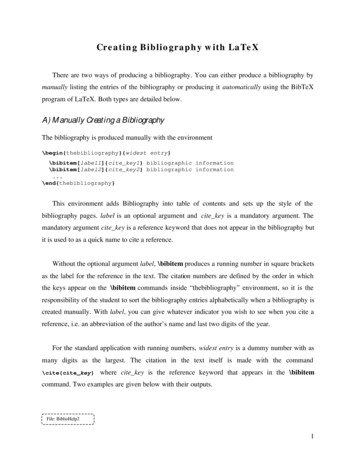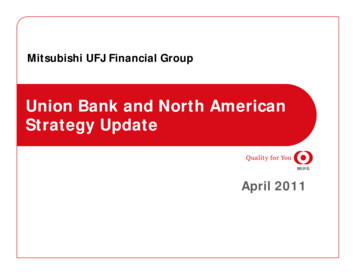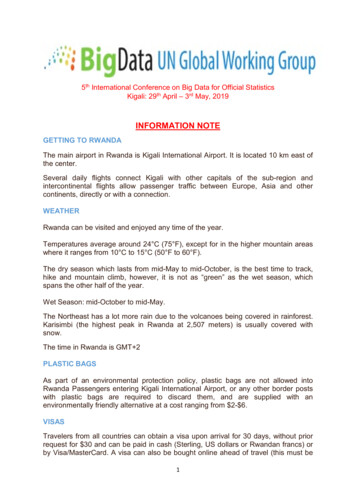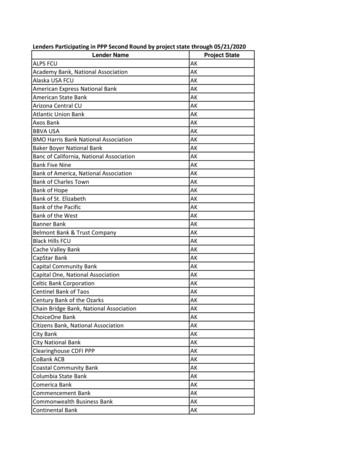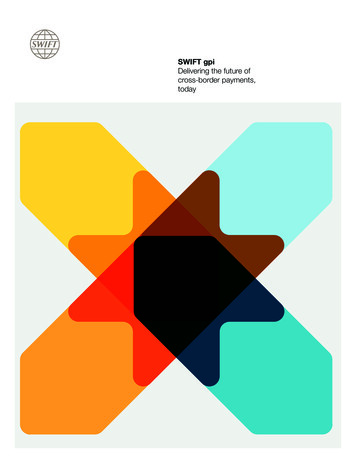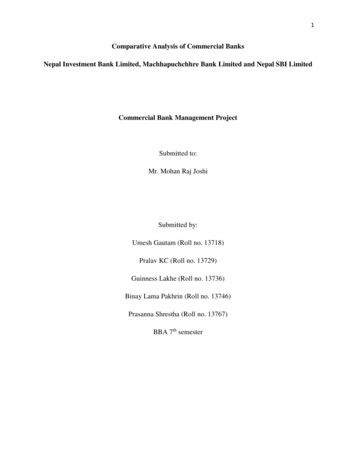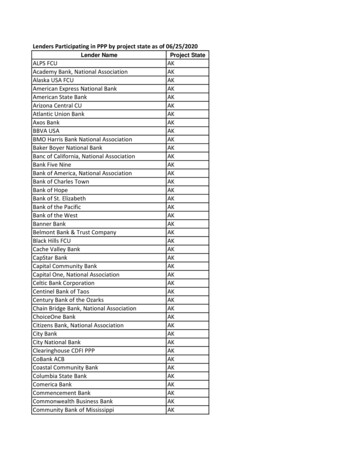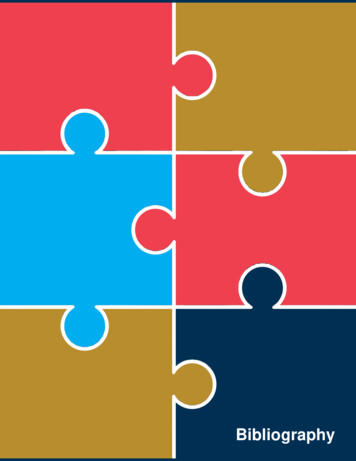
Transcription
Bibliography
Aterido, R., T. Beck, and L. Iacovone. 2013. “Access to Finance in Sub-Saharan Africa: Is There a Gender Gap?”World Development 47: 102–20. doi: 10.1016/j.worlddev.2013.02.013.Barboni, Giorgia, Erica Field, Rohini Pande, Natalia Rigol, Simone Schaner, and Charity Troyer Moore. 2018. ATough Call: Understanding Barriers to and Impacts of Women’s Mobile Phone Adoption in India. Cambridge,MA: Evidence for Policy Design, Harvard Kennedy School. Web.http://www.tinyurl.com/y49xt26n.Bastian, Gautam, Iacopo Bianchi, Mayra Buvinic, Markus Goldstein, Tanvi Jaluka, James Knowles, JoaoMontalvao, and Firman Witoelar. 2018. “Are Mobile Savings the Silver Bullet to Help Women Grow TheirSavings?” Gender Innovation Lab, World Bank, Washington, DC.Berg, Gunhild, and Bilal Zia. 2017. “Harnessing Emotional Connections to Improve Financial Decisions:Evaluating the Impact of Financial Education in Mainstream Media.” Policy Research Working Paper,World Bank Group, Washington, DC.Bill and Melinda Gates Foundation. 2019. “A G7 Partnership for Women’s Digital Financial Inclusion inAfrica.” Report prepared at the request of the G7 French Presidency. Bill and Melinda Gates Foundation,Seattle, WA.Buvinic, Mayra, and Rebecca Furst-Nichols. 2014. “Promoting Women’s Economic Empowerment: WhatWorks?” Policy Research Working Paper, World Bank Group, Washington, DC.Buvinic, Mayra, Rebecca Furst-Nichols, and Emily Courey Pryor. 2013. A Roadmap for Promoting Women’sEconomic Empowerment. Washington, DC: United Nations Foundation; Irving, TX: ExxonMobil Foundation.Buvinic, Mayra, and Megan O’Donnell. 2016. Revisiting What Works: Women, Economic Empowerment,and Smart Design. Washington, DC: Center for Global Development.Campos, Francisco, Michael Frese, Markus Goldstein, Leonardo Iacovone, Hillary Johnson, David McKenzie,and Mona Mensmann. 2018. “Personal Initiative Training Leads to Remarkable Growth of Women-OwnedSmall Businesses in Togo.” Gender Innovation Lab Policy Brief 22. World Bank, Washington, DC. World Bank. 9168 License: CC BY 3.0 IGO.Chamboko, Richard, Soren Heitmann, and Morne Van Der Westhuizen. 2018. “Women and Digital FinancialServices in Sub-Saharan Africa: Understanding the Challenges and Harnessing the Opportunities.” 0350b-4610-4d68-a008-7af5b58639d6/IFC MCF Field Note 10 DFS and Gender in Africa.pdf?MOD AJPERES&CVID mvb-zJp.Chile, Finance Ministry. 2016. “Public Procurement Strategic Plan (2002–2004).” In English. Finance Ministry,Santiago, Chile.Cirera, Xavier, and Qursum Qasim. 2014. “Supporting Growth-Oriented Women Entrepreneurs: A Review of theEvidence and Key Challenges.” Innovation, Technology and Entrepreneurship Policy Note 5. World Bank,Washington, DC.Coca-Cola 5by20. 2016. “Unleashing the Potential of Women Entrepreneurs.” Babson College, Boston, MA.142Using Digital Solutions to Address Barriers to Female Entrepreneurship: A Toolkit
Cuberes, David, and Marc Teignier. 2016. “Aggregate Effects of Gender Gaps in the Labor Market: AQuantitative Estimate.” Journal of Human Capital 10 (1). doi: https://doi.org/10.1086/683847.Deichmann, Uwe, Aparajita Goyal, and Deepak Mishra. 2016. “Will Digital Technologies Transform Agriculturein Developing Countries?” Policy Research Working Paper 7669. World Bank, Washington, DC.Demirguc-Kunt, Asli, Leora Klapper, Dorothe Singer, and Peter Van Oudheusden. 2014. “Global FindexDatabase Report: Measuring Financial Inclusion Around the World.” World Bank, Washington, DC.Demirguc-Kunt, Asli, Klapper, Leora, Singer, Dorothe. and Ansar, Saniya. 2017. “The Global Findex Database:Measuring Financial Inclusion and the Fintech Revolution.” World Bank, DC.Elam, Amanda B., Candida G. Brush, Patricia G. Greene, Benjamin Baumer, Monica Dean, and René Heavlow.2019. Global Entrepreneurship Monitor: 2018/2019 Women’s Entrepreneurship Report. London: GlobalEntrepreneurship Monitor.Elborgh-Woytek, Katrin, Monique Newiak, Kalpana Kochlar, Stefania Fabrizio, Kangni Kpodar, PhilippeWingender, Benedict Clements, and Gerd Scwartz. 2013. “Women, Work and the Economy: MacroeconomicsGains from Gender Equity.” International Monetary Fund, Washington, DC.Elefante, Marina, and Anja Robakowski. 2020. Integrating a Gender Equality Lens: Drawing Lessons from ThreeGood-Practice Development Policy Operations. Equitable Growth, Finance and Institutions Insight. World Bank,Washington, DC. World Bank. 4611 License: CC BY3.0 IGO.99Food and Agriculture Organization (FAO), United Nations. 2013. “The State of Food and Agriculture 2013.”Food and Agriculture Organization of the United Nations, Rome.Global Entrepreneurship Monitor (GEM). 2017. “GEM 2016/2017 Women’s Entrepreneurship Report.” GlobalEntrepreneurship Research Association, London.Hakura, Dalia S., Mumtaz Hussain, Monique Newiak, Vimal Thakoor, and Fan Yang. 2016. “Inequality, GenderGaps and Economic Growth: Comparative Evidence for Sub-Saharan Africa.” IMF Working Paper. InternationalMonetary Fund, Washington, DC.Hossain, Naomi, Celestine Nyamu Musembi, and Jessica Hughes. 2010. “Corruption, Accountability, andGender: Understanding the Connections.” United Nations Development Programme (UNDP) and UnitedNations Development Fund for Women (UNIFEM), New York.ILO (International Labour Organization). 2018. Women and Men in the Informal Economy: A Statistical Picture.3rd ed. Geneva, Switzerland: International Labour Organization.International Finance Corporation (IFC). 2013. “Banking on Women: Changing the Face of the Global Economy.”International Finance Corporation, World Bank Group, Washington, DC.———. 2014. “Women-Owned SMEs, A Business Opportunity for Financial Institutions: A Market and CreditGap Assessment.” International Finance Corporation, World Bank Group, Washington, DC.99.143Field, Erica, Seema Jayachandran, Rohini Pande, and Natalia Rigol. 2016. "Friendship at Work: Can Peer Effects Catalyze Female Entrepreneurship?"American Economic Journal: Economic Policy, 8 (2): 125-53. https://www.aeaweb.org/articles?id 10.1257/pol.20140215Using Digital Solutions to Address Barriers to Female Entrepreneurship: A Toolkit
———. 2017. MSME Finance Gap: Assessment of the Shortfalls and Opportunities in Financing Micro, Small,and Medium Enterprises in Emerging Markets. Washington, DC. International Finance Corporation. 8881 License: CC BY-NC-ND 3.0 IGO.International Finance Corporation and Global Partnership for Financial Inclusion (GPFI). 2011. “StrengtheningAccess to Finance for Women-Owned SMEs in Developing Countries.” International Finance Corporation,Washington, DC, and GPFI.Kazandjian, Romina, Lisa L. Kolovich, Kalpana Kochhar, and Monique Newiak. 2016. “Gender Equality andEconomic Diversification.” IMF Working Paper. International Monetary Fund, Washington, DC.Kelley, Donna, Candida Brush, Patricia Greene, Mike Herrington, Abdul Ali, Penny Kew. 2015. “Special Report:Women’s Entrepreneurship 2015.” Global Entrepreneurship Monitor, Global Entrepreneurship ResearchAssociation, London.Knowles, Jim. 2015. “Measuring Women’s Economic Empowerment Report.” United Nations Foundation,Washington, DC, and ExxonMobil Foundation, Irving, TX.Mansuri, Ghazala, and Vijayendra Rao. 2013. Localizing Development: Does Participation Work? Washington,DC: World Bank. DOI: 10.1596/978-0-8213- 8256-1. License: Creative Commons Attribution CC BY 3.0.McKinsey Global Institute. 2015. “The Power of Parity: How Advancing Women’s Equality Can Add 12 Trillionto Global Growth.” McKinsey Global Institute, New York.Morsy, Hanan. 2020. “Access to Finance: Why Aren’t Women Leaning In?” African Development Bank, Abidjan,Côte d’Ivoire.Nathan Associates Inc. 2016. “Women’s Economic Participation in Peru: Achieving APEC Priorities for GenderEquality.” Produced by Nathan Associates for the United States Agency for International Development. NathanAssociates Inc., and USAID, Washington, DC.National Bureau of Economic Research (NBER). 2019. “Freeing Financial Education via Tablets: ExperimentalEvidence from Colombia.” National Bureau of Economic Research, Cambridge, MA.Ortiz-Ospina, Esteban, and Sandra Tzvetkova. 2007. “Working Women: Key Facts and Trendsin Female Labor Force Participation.” Our World in Data, Oxford, articipation-key-facts.Qasim, Qursum, Zoe Cordelia Lu, and Kalyah Alaina Ford. 2018. Operational Guide to Women’sEntrepreneurship Programs: An Overview. English. Washington, D.C.: World Bank reneurship-Programs-An-Overview.Simavi, Sevi, Clare Manuel, and Mark Blackden. 2010. Gender Dimensions of Investment Climate Reform: AGuide for Policy Makers and Practitioners Washington, D.C.: World Bank Group. World 986/2408 License: CC BY 3.0 IGO.Solutions for Youth Employment (S4YE). 2018. “Digital Jobs for Youth: Young Women in the Digital Economy.”Solutions for Youth Employment, World Bank Group, Washington, DC.144Using Digital Solutions to Address Barriers to Female Entrepreneurship: A Toolkit
Stupnytska, Anna, Kathryn Koch, Amy MacBeath, Sandra Lawson, and Kathy Matsui. 2014. “Giving CreditWhere It Is Due: How Closing the Credit Gap for Women-Owned SMEs Can Drive Global Growth.” GoldmanSachs Global Markets Institute, New York.Suri, Tavneet, and William Jack. 2016. “The Long-Run Poverty and Gender Impacts of Mobile Money.” Science354 (6317): 1288–92.Taylor, Georgia, and Paola Pereznieto. 2014. “Review of Evaluation Approaches and Methods Used byInterventions on Women and Girls’ Economic Empowerment.” Overseas Development Institute, London.United Nations. 2012. “Expanding Usage to Realize the Full Benefits of e-Government.” United Nations eGovernment Survey 2012. New York: United Nations.United Nations Foundation and ExxonMobil Foundation. 2013. Women’s Economic Empowerment: ARoadmap (database). Washington, DC: United Nations Foundation; Irving, TX: ExxonMobil Foundation. http://www.womeneconroadmap.org/the database.———. 2015. “Monitoring and Evaluation Guidelines for Women’s Economic Empowerment Programs.”Washington, DC: United Nations Foundation; Irving, TX: ExxonMobil Foundation.United Nations Economic and Social Commission for Asia and the Pacific (UNESCAP). 2013. “Forward-LookingMacroeconomic Policies.” Annual Report of the Economic and Social Commission for Asia and the Pacific.United Nations Economic and Social Commission for Asia and the Pacific, Bangkok, Thailand.United States Agency for International Development (USAID). 2005. “Enhancing Women’s Access to Markets:An Overview of Donor Programs and Best Practices.”United States Agency for International Development (USAID. 2019. “Evolution of and Prospects for Women’sLabour Participation in Latin America.” Employment Situation in Latin America and the Caribbean 21. EconomicDevelopment Division of the Economic Commission for Latin America and the Caribbean (ECLAC) and theOffice for the Southern Cone of Latin America of the International Labour Organization (ILO), Santiago, Chile.Uteng, Tanu Priya. 2012. Gender and Mobility in the Developing World. Washington, DC: World Bank. World Bank. 111 License: CC BY 3.0 IGO.Watson, John, and Sherry Robinson. 2003. “Adjusting for Risk in Comparing the Performances ofMale-and-Female-Controlled SMEs.” Journal of Business Venturing 18 (6): 773–88.World Bank Group. 2015. Identification for Development (ID4D) Integration Approach. Washington, DC: WorldBank Group. https://www.planetbiometrics.com/creo files/upload/default/ID4D.pdf.———. 2017a. “Gender Strategy (FY16–23): Gender Equality, Poverty Reduction, and Inclusive Growth.” WorldBank Group, Washington, DC. 3425 License: CC BY 3.0IGO.———. 2017b. “Supporting Women Entrepreneurs in Moldova.” World Bank, Washington, .———. 2017c. “Trade and Competitiveness Gender Results Framework.” World Bank Group, Washington DC.———. 2019a. “EFI Gender Implementation Guide.” World Bank, Washington, DC.145Using Digital Solutions to Address Barriers to Female Entrepreneurship: A Toolkit
———. 2019b. Profiting from Parity: Unlocking the Potential of Women’sBusinesses in Africa. World Bank, Washington, DC. World 986/31421 License: CC BY3.0 IGO.———. 2020a. “Blockchain at the Border.” Draft. World Bank Group, Washington, oup,———. 2020d. “The State of the Mashreq Women.” WorldBank Group, Washington, blication/state-of-the-mashreq-women.———. 2020e. Women, Business, and the Law 2020. Women, Business andthe Law. Washington, DC: World Bank. doi:10.1596/978-1-4648-1532-4.License: Creative Commons Attribution CC BY 3.0 IGO.World Bank Group and World Trade Organization (WTO). 2020. Womenand Trade: The Role of Trade in Promoting Gender Equality. Washington,DC: World Bank Group; Geneva, Switzerland: World Trade Organization.World Economic Forum. 2020a. Global Gender Gap Report. World Economic Forum,Cologny, Switzerland.———. 2020b. Global Gender Gap Subindex. World Economic Forum, Cologny,Switzerland.146Using Digital Solutions to Address Barriers to Female Entrepreneurship: A Toolkit
Chile, Finance Ministry. 2016. "Public Procurement Strategic Plan (2002-2004)." In English. Finance Ministry, Santiago, Chile. Cirera, Xavier, and Qursum Qasim. 2014. "Supporting Growth-Oriented Women Entrepreneurs: A Review of the Evidence and Key Challenges." Innovation, Technology and Entrepreneurship Policy Note 5. World Bank,
